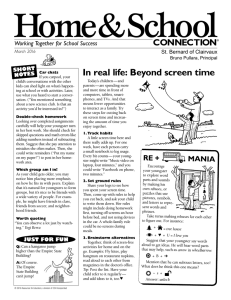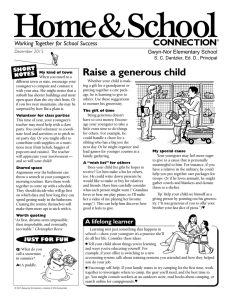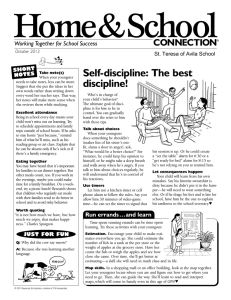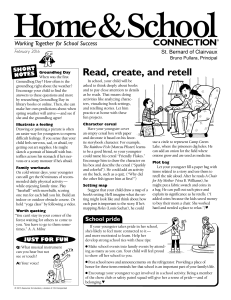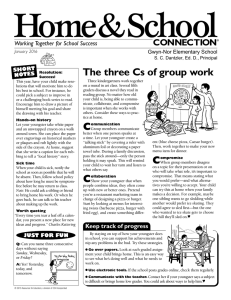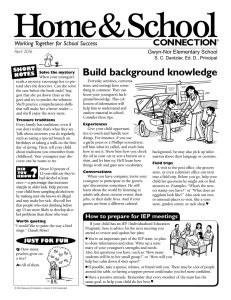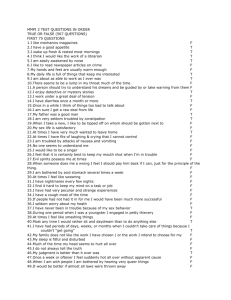Write in a logical sequence November 2015
advertisement
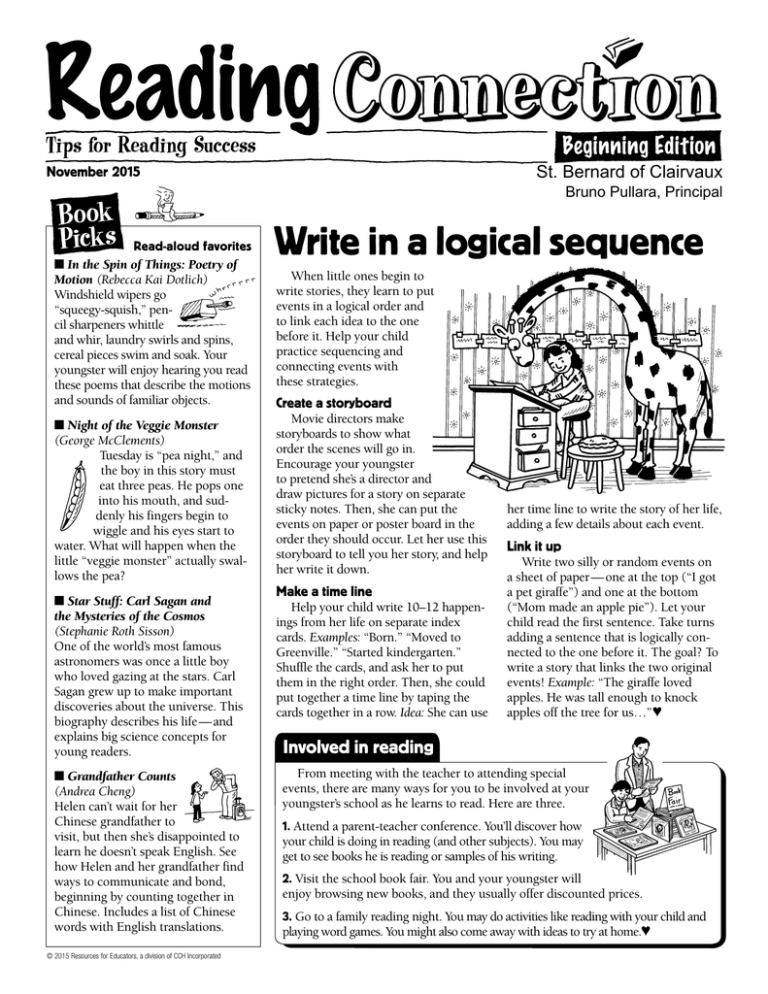
St. Bernard of Clairvaux November 2015 Bruno Pullara, Principal Read-aloud favorites ■ In the Spin of Things: Poetry of Motion (Rebecca Kai Dotlich) Windshield wipers go “squeegy-squish,” pencil sharpeners whittle and whir, laundry swirls and spins, cereal pieces swim and soak. Your youngster will enjoy hearing you read these poems that describe the motions and sounds of familiar objects. Write in a logical sequence When little ones begin to write stories, they learn to put events in a logical order and to link each idea to the one before it. Help your child practice sequencing and connecting events with these strategies. Create a storyboard ■ Night of the Veggie Monster (George McClements) Tuesday is “pea night,” and the boy in this story must eat three peas. He pops one into his mouth, and suddenly his fingers begin to wiggle and his eyes start to water. What will happen when the little “veggie monster” actually swallows the pea? Movie directors make storyboards to show what order the scenes will go in. Encourage your youngster to pretend she’s a director and draw pictures for a story on separate sticky notes. Then, she can put the events on paper or poster board in the order they should occur. Let her use this storyboard to tell you her story, and help her write it down. ■ Star Stuff: Carl Sagan and the Mysteries of the Cosmos (Stephanie Roth Sisson) One of the world’s most famous astronomers was once a little boy who loved gazing at the stars. Carl Sagan grew up to make important discoveries about the universe. This biography describes his life—and explains big science concepts for young readers. Make a time line ■ Grandfather Counts (Andrea Cheng) Helen can’t wait for her Chinese grandfather to visit, but then she’s disappointed to learn he doesn’t speak English. See how Helen and her grandfather find ways to communicate and bond, beginning by counting together in Chinese. Includes a list of Chinese words with English translations. © 2015 Resources for Educators, a division of CCH Incorporated Help your child write 10–12 happenings from her life on separate index cards. Examples: “Born.” “Moved to Greenville.” “Started kindergarten.” Shuffle the cards, and ask her to put them in the right order. Then, she could put together a time line by taping the cards together in a row. Idea: She can use her time line to write the story of her life, adding a few details about each event. Link it up Write two silly or random events on a sheet of paper — one at the top (“I got a pet giraffe”) and one at the bottom (“Mom made an apple pie”). Let your child read the first sentence. Take turns adding a sentence that is logically connected to the one before it. The goal? To write a story that links the two original events! Example: “The giraffe loved apples. He was tall enough to knock apples off the tree for us…”♥ Involved in reading w From meeting with the teacher to attending special events, there are many ways for you to be involved at your youngster’s school as he learns to read. Here are three. 1. Attend a parent-teacher conference. You’ll discover how your child is doing in reading (and other subjects). You may get to see books he is reading or samples of his writing. 2. Visit the school book fair. You and your youngster will enjoy browsing new books, and they usually offer discounted prices. 3. Go to a family reading night. You may do activities like reading with your child and playing word games. You might also come away with ideas to try at home.♥ November 2015 • Page 2 Read to everyone. Have more than one child? Read to them all at once! It’s a nice way for siblings to bond. Plus, when a little one stops you to ask what a word means, an older sibling can take pride in explaining it. Tip: When you have time, try to give each youngster his own read-aloud slot. Story time: 20 minutes of magic Experts recommend that parents read to their children for at least 20 minutes a day. It’s cozy, it’s fun — and it teaches your child skills he can use when he reads on his own. Consider these suggestions for fitting a memorable learning experience into just 20 minutes. Pick the time and place. Try to find times when you can slow down, snuggle up, and read. Choose a place that’s free of distractions, especially electronics. You’ll show your youngster that reading takes priority over the TV and the phone. for little ones. That’s because feeling letters’ shapes helps youngsters remember how to form them. Let your son bend flexible household materials (pipe cleaners, jump ropes) to make letters. Then, he could take a photo of each letter. Print and staple them into a booklet so he can trace over the letters with his finger. At snack time, put cream cheese into a freezer bag, seal, and snip off a corner. Have your child squeeze the cream cheese to form letters on graham crackers. Squeezing the bag will also build small muscles he needs for writing. Finally, unleash your youngster’s creativity. Ask him what else he could use to make letters or write his ABCs on, and watch what he comes up with!♥ O U R P U R P O S E To provide busy parents with practical ways to promote their children’s reading, writing, and language skills. Resources for Educators, a division of CCH Incorporated 128 N. Royal Avenue • Front Royal, VA 22630 540-636-4280 • rfecustomer@wolterskluwer.com www.rfeonline.com ISSN 1540-5648 © 2015 Resources for Educators, a division of CCH Incorporated Design an animal home Animals are clever engineers! Your youngster can practice reading for detail—and explore engineering—by reading a nonfiction book about an animal and building a model of its home. Have her read closely for details that will help. For instance, she might read, “Prairie dogs make mounds with holes, or craters, to help prevent flooding in their burrows.” Then, she could build a model of a burrow out of clay—complete with a crater. Program a “robot” Here’s a fun way for your child to write in another “language.” Pretend to be a robot, and let her write a code to “program” you. First, let her list actions and assign a symbol to each. Example: “ = jump, O = twirl.” Next, she should write a string of symbols and numbers showing you what to do. Example: “3 O 2 ” means jump three times, twirl, and jump twice. Switch roles — now you’re the coder, and she’s the robot.♥ → A Hands-on alphabet activities are ideal ● Combine reading and writing with STEM (science, technology, engineering, and math) to give your child a leg up on these important areas. Try these activities. → ● Q My son is learning to write his ABCs. How could we practice at home? Reading, writing, and STEM → Awesome alphabet activities Introduce new books. Start a new tradition in just 20 minutes. Favorite books are often passed down through generations— use story time to share books you loved as a child. Your enjoyment will shine through as you read, which can inspire your youngster to love reading, too.♥ Be a spelling family Learning to spell doesn’t end when you finish school. Show your youngster that spelling is a lifelong endeavor with these ideas that will help her study for spelling tests and learn new words: ● Hold a family spelling bee. Give your child words from her school spelling list. On your turn to spell, she gets to pick a word from the dictionary to try to stump you. Play double or triple elimination to make your spelling bee last longer. ● Have each person learn to spell at least one new word per week and add it to a list on the refrigerator. Your youngster might add words she likes from books, such as neon or velvet. Adults can choose long words like onomatopoeia or lackadaisical —seeing these on your list will introduce your child to big words that are fun to say.♥

